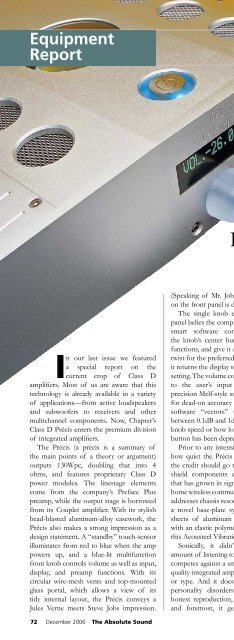Create successful ePaper yourself
Turn your PDF publications into a flip-book with our unique Google optimized e-Paper software.
Equipment<br />
Report<br />
Chapter Electronics<br />
Précis Integrated Amplifier<br />
The genuine article in Class D amplification<br />
Neil Gader<br />
In our last issue we featured<br />
a special report on the<br />
current crop of Class D<br />
amplifiers. Most of us are aware that this<br />
technology is already available in a variety<br />
of applications—from active loudspeakers<br />
and subwoofers to receivers and other<br />
multichannel components. Now, Chapter’s<br />
Class D Précis enters the premium division<br />
of integrated amplifiers.<br />
The Précis (a précis is a summary of<br />
the main points of a theory or argument)<br />
outputs 130Wpc, doubling that into 4<br />
ohms, and features proprietary Class D<br />
power modules. The linestage elements<br />
come from the company’s Preface Plus<br />
preamp, while the output stage is borrowed<br />
from its Couplet amplifier. With its stylish<br />
bead-blasted aluminum-alloy casework, the<br />
Précis also makes a strong impression as a<br />
design statement. A “standby” touch-sensor<br />
illuminates from red to blue when the amp<br />
powers up, and a blue-lit multifunction<br />
front knob controls volume as well as input,<br />
display, and preamp functions. With its<br />
circular wire-mesh vents and top-mounted<br />
glass portal, which allows a view of its<br />
tidy internal layout, the Précis conveys a<br />
Jules Verne meets Steve Jobs impression.<br />
72 December 2006 The Absolute Sound<br />
(Speaking of Mr. Jobs, the mini input jack<br />
on the front panel is designed for iPod use.)<br />
The single knob elegance of the front<br />
panel belies the complexity of the Chapter’s<br />
smart software control. Simply punch<br />
the knob’s center button to cycle through<br />
functions, and give it a forward or backward<br />
twist for the preferred setting. Release it and<br />
it returns the display to the previous volume<br />
setting. The volume control is speed sensitive<br />
to the user’s input and employs ultraprecision<br />
Melf-style surface-mount resistors<br />
for dead-on accuracy at any level. Chapter’s<br />
software “vectors” the controller speed<br />
between 0.1dB and 1dB steps depending on<br />
knob speed or how long the remote-control<br />
button has been depressed.<br />
Prior to any intensive listening, I noticed<br />
how quiet the Précis was. At least part of<br />
the credit should go to Chapter’s efforts to<br />
shield components against RF—an issue<br />
that has grown in significance in the age of<br />
home wireless communications. Chapter also<br />
addresses chassis resonance control by using<br />
a novel base-plate system in which three<br />
sheets of aluminum are bonded together<br />
with an elastic polymer agent. Chapter calls<br />
this Acousteel Vibration Control.<br />
Sonically, it didn’t take a substantial<br />
amount of listening to realize that the Précis<br />
competes against a small fraternity of highquality<br />
integrated amps, irrespective of class<br />
or type. And it does so not by accenting<br />
personality disorders but by hewing to<br />
honest reproduction, top to bottom. First<br />
and foremost, it gets the meat of the<br />
tonal spectrum spot on. The midrange is<br />
as rich and satisfying as a Kobe steak; the<br />
lower midrange and midbass resolution<br />
are striking in their tonal density, with<br />
just a hint of warmth yet an overriding<br />
sense of evenness throughout. Channel<br />
separation—an area that normally isn’t a<br />
strength of integrated amps—is excellent.<br />
At its frequency extremes, the Précis doesn’t<br />
quite have the brute force to drag the lower<br />
depths or the subtlety to elicit a whisper of<br />
harmonic bloom at the treble’s summit, but<br />
I never felt short-changed, either.<br />
What the Précis does do is grip low-level<br />
information with the kind of punch and<br />
energy that emerge from real instruments<br />
played in an acoustic space. During Sinatra’s<br />
“Angel Eyes” from Only The Lonely [Capitol],<br />
it unearthed the deep bass line and a gang<br />
of other musical treasures to a degree that<br />
I didn’t think possible. Not the least of<br />
which was Sinatra’s vibrato—an element of<br />
his delivery that he used sparingly. Even the<br />
delicate harp accompaniment was followed<br />
so precisely that I found myself leaning<br />
slightly forward in order to hear deeper<br />
into the mix. And even if it didn’t play back<br />
the bass of Claire Martin’s “Black Coffee”<br />
from Linn’s Too Damn Hot CD as well as<br />
the Conrad Johnson CA200 or the MBL<br />
7008, the depth from the snare drum and<br />
the natural timbre and growl of a sliding<br />
bass string was more than enough to send a<br />
couple of shivers down my spine.<br />
Transient response is a strong suit<br />
with the Précis. During Arturo Delmoni’s










